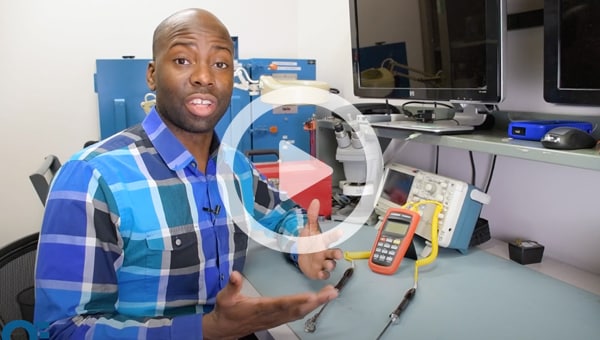A signal conditioner is a device that modifies raw analog output signals produced by sensors and provides the essential circuitry between the sensor and the data acquisition system. These modifications convert these various signals into signals that are compatible with process monitoring and control devices. For each specific sensor, a signal conditioner serves as an interface to excite, scale, or buffer real-world signals. Signal conditioner types differ both by the physical value they measure as well as by their specific features.
Types of Signal Conditioners According to Physical Value Measurement
Temperature Signal Conditioners
A temperature signal conditioner is compatible with sensors that measure temperature or variations in temperature. Temperature signal conditioners are used to amplify the analog signals produced by temperature sensors, to filter out noise, and to push the signals forward for further analysis and display.
Thermocouples
Thermocouples are commonly used in many industrial application processes. Usually, thermocouple output is within the range of ±80 mV. With such low output voltage, it is difficult for process monitoring and control devices to record and display the raw analog signal. Temperature signal conditioners amplify these signals.
In addition to amplification, signal conditioning is also necessary for cold junction compensation when processing the analog signal produced by a thermocouple. When a thermocouple is connected to an instrument for temperature measurement, the material difference generates a voltage at junctions known as “cold junctions” – which affects the actual output of the thermocouple, giving out erroneous results. Temperature signal conditioners compensate for such variations.
Temperature signal conditioners also perform linearization on the analog signal – so that the output voltage of a thermocouple is linear with temperature.
Thermistors
A thermistor is another commonly used temperature sensor in a variety of industrial applications. Thermistors are active temperature sensors – and as such, require current and voltage excitation. The stability and accuracy of the excitation signal directly affects the stability and accuracy of the sensor. Temperature signal conditioners also provide amplification and low pass filtering for thermistors – performing these operations to modify signals so that they can be easily read by the digital devices of the data acquisition system.
RTDs
Resistance Temperature Devices, or RTDs, are temperature sensors that use variation in resistance to calculate temperature. RTDs, like thermistors, require excitation voltage, amplification, and filtering – all of which can be performed by a temperature signal conditioner. RTD signal conditioning also eliminates unwanted signals from line resistance, non-linearity, and self-healing.
Pressure Sensor Signal Conditioners
A pressure sensor signal conditioner is compatible with sensors that measure pressure. Pressure sensors work by monitoring the strain or stress experienced by a bridge. The pressure signal conditioner excites the bridge by providing constant voltage and amplifying the output signals. The output of the pressure sensor varies in millivolts along with high common-mode signals.
The pressure sensor signal conditioner eliminates common-mode signals while retaining pressure variation values.
Load Cell/Strain Signal Conditioners
Load cells or strain gauges measure force on a device in either tension or compression – and they produce output in the range of low dc millivolts. The load cell/strain gauge signal conditioner is necessary to pick up these small variations to ensure accurate measurement and amplify the signal to the appropriate Data Acquisition device. Load cells along with strain gauges also require excitation voltage in the range of 2.5V to 10V – and this is achieved using a signal conditioner.
LVDT Signal Conditioners
Linear Variable Differential Transformers, or LVDTs, measure the position of a subject. A sinusoidal excitation wave (between 400 kz and 10 kHz) is required to excite the LVDT sensor. The output is then passed through a low pass filter to ensure that the noise levels are kept to a minimum. The final signal sent by the signal conditioner is easy to recognize for digital reading devices within the data acquisition system.
Torque Signal Conditioners
Torque signal conditioners follow the suite of the load and pressure signal conditioner as it can produce low or high output voltage based on the excitation voltage of the sensor.
DC and AC Signal Conditioners
DC signal conditioning is usually required to either convert or amplify a DC current or voltage signal – and is required to reject signal noise, which is done by filtering the input.
AC signal conditioners are used to accept AC current or voltage signals and convert them to DC current or voltage signals that are appropriate for terminating instrumentation.
Frequency Signal Conditioner
Frequency signal conditioners allow for a variety of different sensors that produce frequency outputs that are converted to a usable analog DC output signal that can be easily measured using popular measurement devices.
Types of Signal Conditioners According to Features
Universal Signal Conditioners
A universal signal conditioner is a device that can be programmed for multiple combinations of input/output configurations. Accepting current, voltage, thermocouple, RTDs, and potentiometer and linear resistance signals, the device makes it easy to connect the most common sensors without requiring a separate signal conditioner for each. Universal signal conditioners come with a programmable module that allows configuring for specific input/output requirements.
Multi-Channel Signal Conditioners
A multi-channel signal conditioner is similar to a universal signal conditioner, but while a universal signal conditioner allows for only one input and one output, a multi-channel signal conditioner will have two more input/output options.
Isolated Signal Conditioners
Isolated signal conditioners are often useful in applications where the signals from the source to the measuring devices are required to be transmitted without a physical connection. Isolators also prevent undesirable ground loop currents and protect the control system from transients and electrical noise produced due to unpredictable field conditions.
Signal Conditioner Splitter
A signal conditioner splitter accepts one input signal and splits the output into two identical signals through two separate channels. These channels are isolated from each other and work independently. The isolation further helps in preventing ground loops and transient signals. These devices are useful in applications that require output measurement at two different areas from a single repeater base unit.



